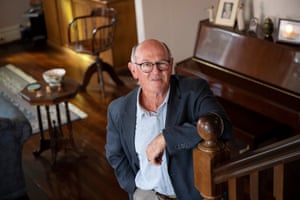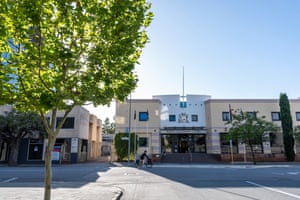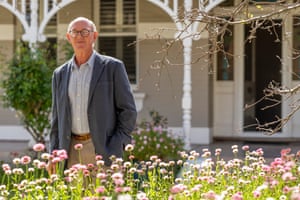Extract from The Guardian

Denis Reynolds led the children’s court of Western Australia from 2004 until his retirement in 2018. Photograph: David Dare Parker/The Guardian
The judge: As president of WA’s children’s court, Denis Reynolds was shocked by sentences given to youngsters facing ‘horrific’ circumstances
When Denis Reynolds began his career as a magistrate nearly 40 years ago, some of the Aboriginal children who appeared before him were so young and small he could hardly see them above the desk. Most, he says, “have no concept of the level of seriousness of what they’ve been engaged in”.
Now retired from the court he reflects on 14 years as president of the children’s court of Western Australia – and wonders how much has changed.
Throughout the 80s and 90s Reynolds was working as a magistrate in Kalgoorlie, then in Perth, flying out to regional cities and remote communities as needed. In the late 90s he became commissioner of the district court.
He saw a fundamental shift in the way the court dealt with children. He believes more and more weight was being put on the seriousness of the offence rather than the children’s welfare.
“[A] welfare-orientated court shifted to more of a ‘law and order’ court, where children were dealt with like young adults,” he says.
This shift disproportionately impacted Indigenous children, who on average make up three-quarters of the state’s youth detention population.
By the time he was appointed president of the children’s court in 2004, he realised that things had to change, and he had the power to do it.
The children’s court oversees all matters involving children between 10 and 17 years old across the state. In West Australia, the president takes on more serious criminal matters that come before the court, while also hearing appeals and reviewing the court’s decisions.
Reynolds says he was determined to reset the culture among his magistrates and the WA government, with the guiding principle of treating children like children.
“It’s like a metronome,” he says. “We’ve gone too far into the law and order … model.
“We’ve got to go back and start addressing the underlying cause … the factors for why young children offend, and place more regard on that principle – that seems to be lost – that we’re dealing with children.”

He remembers the case of a 13-year-old Indigenous girl from the Kimberley who was charged with burglary, among other things. The child had been in and out of the system for a few years already, had a history of being sexually abused and was neurologically impaired from being born with foetal alcohol spectrum disorder, or FASD. She was arrested and flown to Perth, thousands of kilometres away, to attend court.
Reynolds says it was clear the girl didn’t fully appreciate what was going on, or the seriousness of the charges against her.
Despite her cognitive difficulties, she was given a custodial sentence and taken to the only youth detention centre in the state, Banksia Hill detention centre in Perth.
Her case is not uncommon. A 2018 report found that 89% of Banksia hill detainees had at least one form of severe neurodevelopmental impairment, while 36% were found to have FASD.
When the girl’s appeal reached Reynolds, he looked at her case and was shocked.
“To treat a young girl with horrific personal circumstances like that … I thought, can’t we do better than this? This young girl is just the victim in so many respects. And yet we’re pushing her through a criminal justice system rather than providing the necessary therapeutic support.”
He overturned her sentence and found an option that didn’t require detention. But he says there aren’t enough sentencing options for magistrates inside the courtroom, with legislation around mandatory sentencing – which sets minimums sentences for certain offences – causing outcomes “which are unjust, and not in the best interests of the child and the community”.
“Children are not small adults and they should not be treated as such, legislatively or at all,” he says.
He also cites issues with bail laws. In WA, if a young person is charged with a serious offence, such as a burglary, and is granted bail, but then comes back before the court on another offence, it becomes much harder to grant bail unless there are “exceptional circumstances”.
“A burglary can consist of some young person who hasn’t eaten for a while, knowing there’s no one at home, going into an open back door and going to the fridge and taking whatever he or she can get out of the fridge to eat, and then leaving the house.”
He wants to see legislation and a court system that steer kids like that back into the community, not the courts or detention centres.

“The heavy lifting needs to be done outside the court,” he says. “And heavy lifting outside the court involves empowering Aboriginal people.”
Diversion programs are thin on the ground in WA, he says, especially when it comes to Indigenous kids.
“Let’s just say we’ve got a cliff, and we’ve got young children dropping off the cliff,” he says. “We’re pretty much at the bottom of the cliff.
“We need to be at the top of the cliff, working on what’s going wrong up there [to stop] these children dropping off.”
Parallel to investing in these diversion programs, he believes Australia should raise the age of criminal responsibility from 10 to 14.
“If we fill the void [of youth detention] with the prevention and diversion programs with Aboriginal involvement that I’m talking about, you’ll actually not only improve the lifespan and the quality of life … you’ll also make the community a safer place.”
For him it all comes down to his guiding principle – treating kids as kids.
“What this whole system does is it divides kids into good kids and bad kids,” he says. “We’re putting kids with neurodevelopmental impairments and other very serious underlying issues – homelessness, abuse, sexual, emotional, that sort of stuff – we’re saying they’re bad kids.
“What we should be saying is that they’re kids crying out for support, and we need to provide it.”

No comments:
Post a Comment